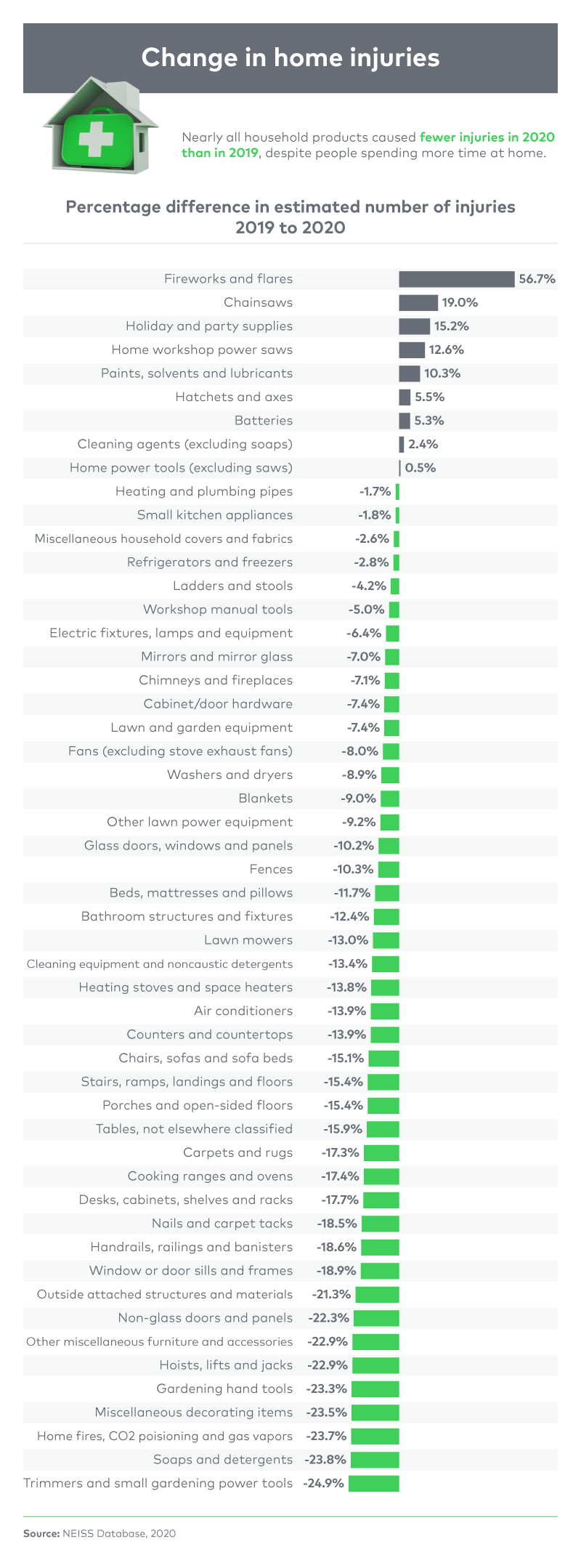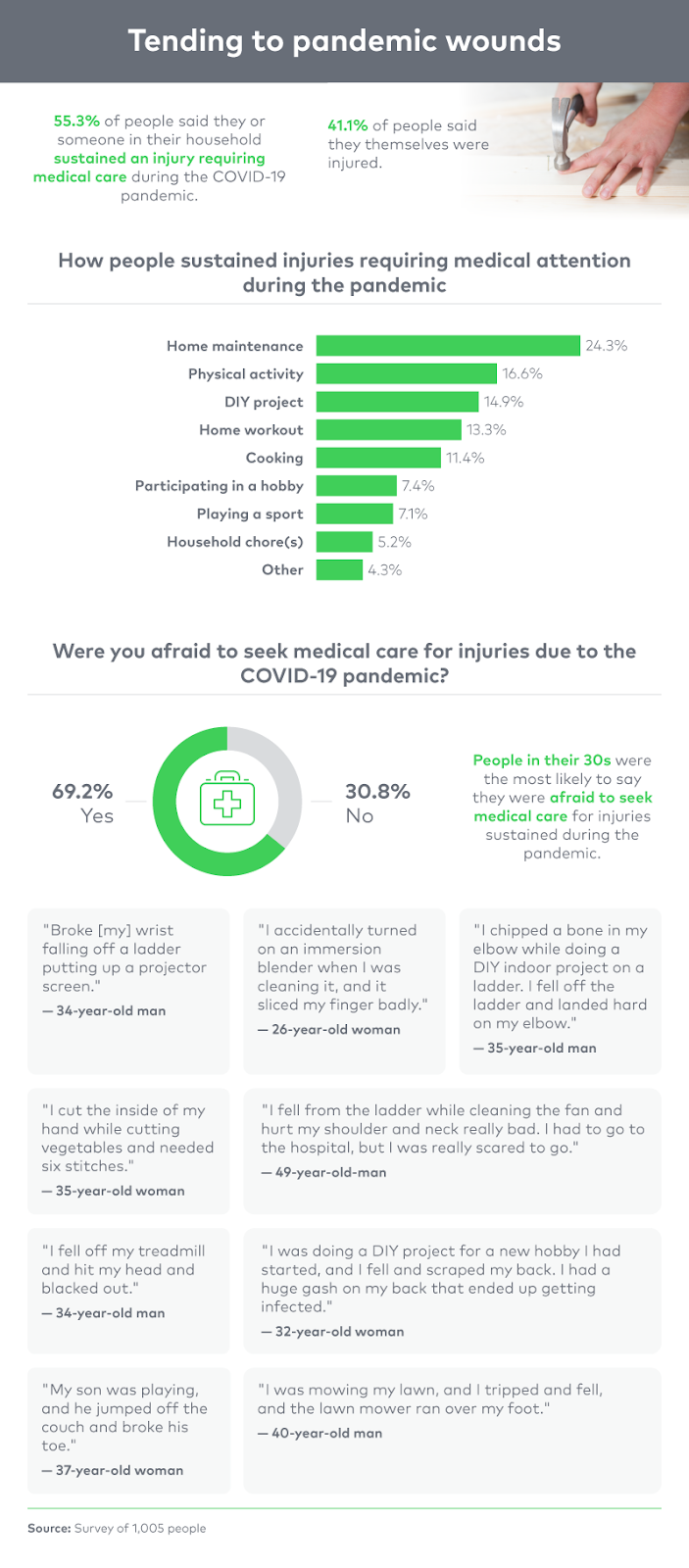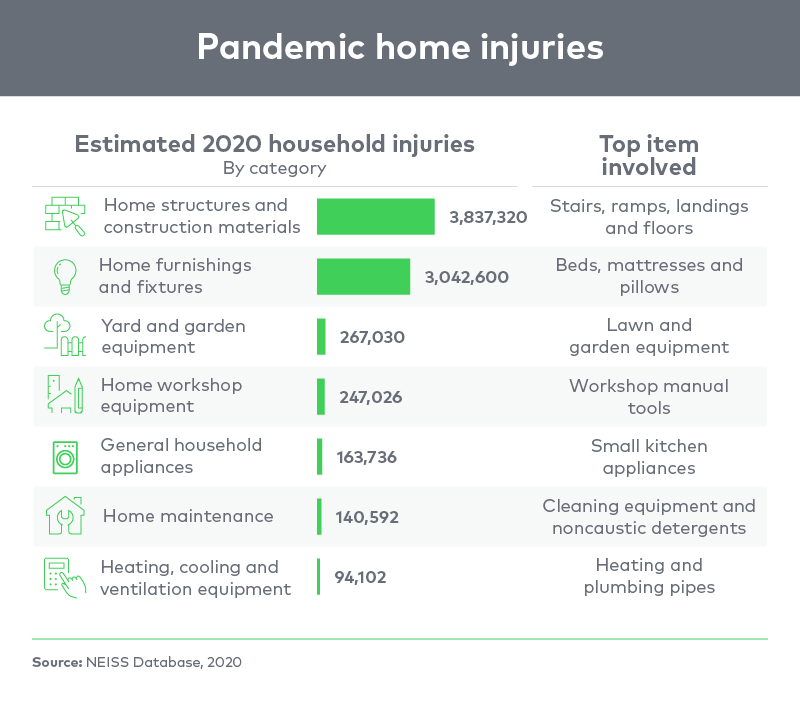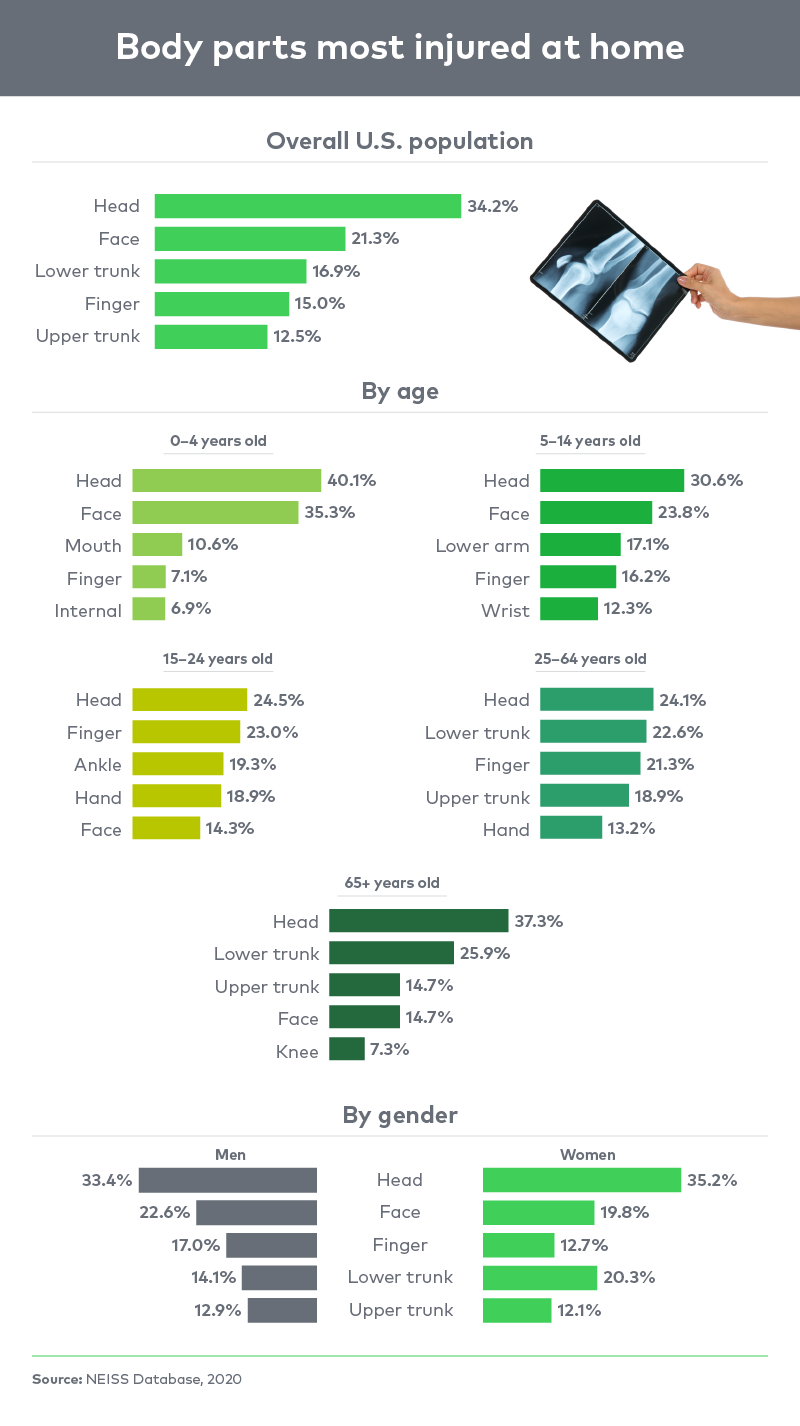Key takeaways
- Most household products caused fewer injuries in 2020 than in 2019
- Home maintenance was the top cause of injuries requiring medical attention during the pandemic
- 55.3% of people said they or someone in their household sustained an injury requiring medical care during the pandemic
The COVID-19 pandemic is likely to be a long chapter in the history books of the future. It presented the world with unprecedented challenges to health, societies and economies. Being trapped inside during such a stressful time presented its own challenges. From cabin fever to maintaining motivation to social isolation, people around the world struggled to stay healthy both physically and mentally during the pandemic. For many, this meant digging into new hobbies and home projects, both of which brought new joys to many Americans. But as fun as hobbies and home DIY projects are, such activities can present their own challenges: namely, how to be a DIY hobbyist safely.
While much of the focus during the pandemic was on COVID-19 medical cases, we wanted to explore how minor injuries impacted the U.S. during the pandemic. What injuries did people sustain during the pandemic, and what consumer products were the cause? To answer these questions, we pulled data from the National Electronic Injury Surveillance System (NEISS), which tracks ER visits caused by consumer products. We coupled this with a survey of over 1,000 people who we queried regarding their experiences with injuries during the COVID-19 pandemic. Read on to see what we discovered.
Home injuries during COVID-19
The good news is that despite people spending more time at home last year than in previous years, nearly all household products caused fewer injuries in 2020 than in 2019. Trimmers and small gardening power tools, for instance, caused nearly 25% fewer injuries in 2020 than they did in 2019. Other garden tools also caused over 23% fewer injuries during the year, even though people were gardening more than ever before during the pandemic.
 Soaps and detergents also caused considerably fewer injuries in 2020, at almost 24% less than 2019. This is another surprising find given the pandemic significantly increased the demand for cleaning products and upped the hygiene ante in people’s homes.
Soaps and detergents also caused considerably fewer injuries in 2020, at almost 24% less than 2019. This is another surprising find given the pandemic significantly increased the demand for cleaning products and upped the hygiene ante in people’s homes.
Home fires, carbon dioxide poisoning and gas vapors also saw a considerable reduction in injuries during 2020. These home hazards caused 23.7% fewer injuries during the pandemic than they did during 2019. And while home cooking was on the rise during the pandemic, people were staying relatively safe while doing it: According to NEISS data, cooking ranges and ovens caused over 17% fewer injuries in 2020 than in 2019. Likewise, small kitchen appliances caused almost 2% fewer injuries during the year. Even refrigerators and freezers were less involved in accidents with 2.8% fewer injuries caused by these major appliances in 2020 than in 2019.
The household products that did not prove less hazardous are few. They range from home power tools (excluding saws) causing 0.5% more injuries in 2020 to fireworks and flares, which saw the largest increase in injuries during 2020 at 56.7%. Also of note is that despite social distancing being in place for most of the year, holiday and party supplies caused over 15% more injuries during the pandemic than the year before.
Causes of home injuries during COVID-19
Despite a drop in ER visits from injuries caused by consumer products, the majority of people (55%) knew someone who was injured during the pandemic. For over 41% of those people that person was themselves. How were those injuries sustained?

By far the most common way people were injured during the pandemic was through home maintenance, which more than 24% of people cited for an injury requiring medical attention. One 49-year-old man told us he fell from a ladder while cleaning a fan. Despite severely hurting his neck and shoulder, he was scared to go to the hospital.
This fear was a common sentiment among respondents. Over 69% said they were afraid to seek medical attention during the pandemic. ER visits fell by 42% nationwide during April 2020, compared to the same time period in 2019.
Physical activity was another common cause of injury during the pandemic. Around 16.6% of people said they were injured to the point of needing medical attention while trying to stay active during COVID-19. Home workouts caused 13.3% of the injuries requiring medical attention among our respondents, such as the 34-year-old man who hit his head so hard falling off his treadmill that he blacked out. Even young children had trouble staying active and safe, as one 37-year-old woman told us: Her son jumped off the couch while playing and broke his toe, requiring a doctor visit.
Unsurprisingly, DIY projects were also an activity prone to causing injuries during 2020. Almost 15% of injuries requiring medical attention stemmed from projects of this type. For instance, one 34-year-old man broke his wrist falling off a ladder while putting up a projector screen. Another man took a similar tumble doing an indoor DIY project and ended up chipping a bone in his elbow. One woman scraped her back from falling while doing a new hobby. The gash was so bad it got infected and required medical attention.
Home areas where injuries occur most
Returning to the NEISS data, if we break the injury reports into categories, a clear trend emerges. By far the most household injuries were caused by home structures and construction materials. Over 3.8 million people sustained injuries from home structures and construction materials. What were the most injury-inducing structures? Stairs, ramps, landing and floors. Slippery floors and outlets can be particularly treacherous, so don’t be shy about making use of nonslip mats and GFCI outlets, which are designed to shut off power if it detects an imbalance in electrical current to reduce the risk of shock.

Close behind home structures and construction materials in terms of number of injuries caused was the home furnishings and fixtures category, which caused just over 3 million injuries in 2020. Most of these were caused by beds, mattresses and pillows, which may suggest people were getting more creative in the bedroom during the pandemic. In fact, experts say intimacy-related injuries may be more common than you think. One OBGYN pointed out that there’s no formal stat on these injuries’ frequency, but they’re likely more common than what’s assumed since many people might not be eager to report them.
After these top two categories, the number of injuries per category dropped off significantly. The next highest injury-causing category was yard and garden equipment, but this only caused around 267,000 injuries during 2020, far less than the over 3 million caused by each of the top two categories.
Where we were injured the most
We now know where in the home people sustained the most injuries. The next question to ask is where on their body did these injuries occur?

Looking at the overall U.S. population, the most common body part to get injured during 2020 was the head at about 34%. In fact, across every age and gender, the head was the most injured body part. Interestingly, while every age group was the most prone to head injuries, adults aged 15 to 64 were almost as likely to injure their finger or lower trunk as they were their heads.
The next most commonly injured body part across the whole U.S. population was the face (21.3%). Infants and toddlers were the most likely to injure their face, with 35.5% of injuries to 0- to 4-year-olds occuring on the face. Children and young teens between the ages of 5 and 14 were also prone to face injuries, but after 14 years of age, people seemed better equipped at protecting their faces in 2020.
What people injured more with age was their lower trunk. While the average population injured their lower trunk under 17% of the time, 22.6% of injuries incurred by people aged 25 to 64 were their lower trunk, and almost 26% of senior citizen injuries were to their lower trunk.
Women were more likely than men to have lower trunk injuries, while men were more likely than women to injure their faces in 2020. Women were also slightly more likely to injure their heads than men. Meanwhile, men had more finger and upper trunk injuries than women in 2020.
Staying safe at home
Your home is supposed to be a safe place. It’s where you go to relax and unwind, and where we were all forced to spend most of our time while social distancing during the COVID-19 pandemic. Luckily for most, the increased time at home translated to fewer injuries during the year. According to NEISS data, nearly all household products caused fewer injuries in 2020 than in 2019.
When people did get injured at home, it was largely while trying to do home maintenance. As many homeowners could tell you, caring for a home is no simple task. Not only can home maintenance be grueling and time-consuming work, it can also be dangerous, as our survey revealed. But that needn’t be the case. At Cinch Home Services, our home warranties can help ensure your home keeps running smoothly even if you aren’t there to fix it. We also provide on-demand appliance repair with prescreened local service professionals in select markets. Visit cinchhomeservices.com to learn more about both our warranties and repair specialists.
Methodology and limitations
Using data from the National Electronic Injury Surveillance System, we analyzed experiences with injuries resulting in ER visits during 2019 and 2020. With the exception of the portion of this study on the specific body parts that were injured, we used weighted estimates provided by NEISS. The body part data was calculated using raw numbers.
The United States Consumer Product Safety Commission considers a national estimate unstable and potentially unreliable under the following circumstances:
- the estimate is less than 1,200 or
- the number of cases is less than 20, or
- the CV exceeds 33%
Our data were not checked for compliance with this, so it should be considered for exploratory purposes only.
We also surveyed 1,005 Americans about their experiences with injuries requiring medical attention during the pandemic. Respondents were 51% men and 48.5% women. Five respondents were nonbinary, and one respondent chose not to disclose their gender. The average age of respondents was 39.7.
The survey data presented rely on self-report. There are many issues with self-reported data. These issues include, but are not limited to, the following: selective memory, telescoping, attribution, and exaggeration.
Fair use statement
Home safety is important. If you know someone who could benefit from the findings included in this report, we’d be glad for you to share it with them. We ask only that you do so strictly for noncommercial purposes and include a link back to this page when you do so that everyone can appreciate the findings in their entirety.